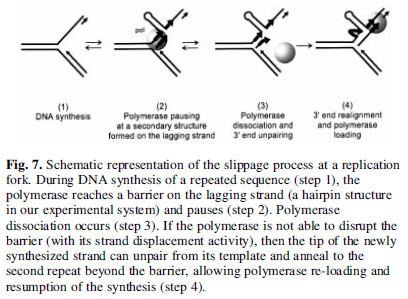 | ||
Replication slippage, otherwise known as slipped-strand mispairing, is a form of mutation that leads to either a trinucleotide or dinucleotide expansion or contraction during DNA replication. A slippage event normally occurs when a sequence of repetitive nucleotides (tandem repeats) are found at the site of replication. Tandem repeats are unstable regions of the genome where frequent insertions and deletions of nucleotides can take place, resulting in genome rearrangements. DNA polymerase, the main enzyme to catalyze the polymerization of free deoxyribonucleotides into a newly forming DNA strand, plays a significant role in the occurrence of this mutation. When DNA polymerase encounters a direct repeat, it can undergo a replication slippage.
Slippage occurs through five main stages:
- In the first step, DNA polymerase encounters the direct repeat during the replication process.
- The polymerase complex suspends replication and is temporarily released from the template strand.
- The newly synthesized strand then detaches from the template strand and pairs with another direct repeat upstream.
- DNA polymerase reassembles its position on the template strand and resumes normal replication, but during the course of reassembling, the polymerase complex backtracks and repeats the insertion of deoxyribonucleotides that were previously added. This results in some repeats found in the template strand being replicated twice into the daughter strand. This expands the replication region with newly inserted nucleotides. The template and the daughter strand can no longer pair correctly.
- Nucleotide excision repair proteins are mobilized to this area where one likely outcome is the expansion of nucleotides in the template strand while the other is the absence of nucleotides. Although trinucleotide contraction is possible, trinucleotide expansion occurs more frequently.
Tandem repeats (the main influence for slippage replication) can be found in coding and non-coding regions. If these repeats are found in coding regions then the variations to the polynucleotide sequence can result in the formation of abnormal proteins in eukaryotes. Many human diseases have been reported to be associated with trinucleotide repeat expansions including Huntington's disease. The HD gene is found in all human genomes. In the event that a slippage event occurs there can be a large expansion in the tandem repeats of the HD gene. An individual who is not affected by Huntington’s disease will have 6-35 tandem repeats at the HD locus. However, an affected individual will have 36- 121 repeats present. The expansion of the HD locus results in a dysfunctional protein leading to Huntington’s disease.
Huntington disease is normally progressive and results in movement, cognitive and psychiatric disorders. These disorders can lead to a severe impact on an individual’s daily activities, making it hard for proper communication and independent actions to take place. Replication slippage can also lead to other neurodegenerative diseases in humans. These include Spinal and bulbar muscular atrophy ( trinucleotide expansion in the AR gene), Dentatoribral-pallidoluysian atrophy ( trinucleotide expansion in the DRPLA gene), Spinocerebellar ataxia type 1 ( trinucleotide expansion in the SCA1gene), Machado-Joseph disease ( trinucleotide expansion in the SCA3 gene), Myotonic dystrophy( trinucleotide expansion in the DMPK gene), and Friedreich's ataxia ( a trinuncleotide expansion in the X25 gene). Therefore, replication slippage leads to a form of trinucleotide expansion which results in serious changes to protein structure.
